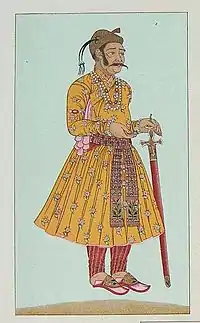Murad Bakhsh
Muhammad Murad Bakhsh (Urdu: مُحمّد مُراد بخش ), (9 October 1624 – 14 December 1661[1]) was a Mughal prince and the youngest son of Mughal Emperor Shah Jahan and Empress Mumtaz Mahal.[2] He was the Subedar of Balkh, till he was replaced by his elder brother Aurangzeb in the year 1647.
| Murad Bakhsh مُراد بخش | |||||
|---|---|---|---|---|---|
| Shahzada of the Mughal Empire | |||||
 | |||||
| Born | 8 October 1624 Rohtasgarh Fort, Bihar, India | ||||
| Died | 14 December 1661 (aged 37) Gwalior Fort, Madhya Pradesh, India | ||||
| Burial | Traitor's Cemetery (Gwalior) | ||||
| Spouse | Sakina Banu Begum One another wife | ||||
| Issue | Muhammad Yar Mirza Izzad Bakhsh Mirza Dostdar Banu Begum Asaish Banu Begum Hamraz Banu Begum | ||||
| |||||
| House | Timurid | ||||
| Father | Shah Jahan | ||||
| Mother | Mumtaz Mahal | ||||
| Religion | Islam | ||||
Family
Muhammad Murad Bakhsh was born on 9 October 1624, at the Rohtasgarh Fort in Bihar, as the youngest son of Emperor Shah Jahan and his beloved wife, Mumtaz Mahal. Murad's siblings included his two politically powerful sisters, the princesses Jahanara Begum and Roshanara Begum, as well as the heir-apparent to his father, his eldest brother, Crown Prince Dara Shikoh and the future Mughal Emperor Aurangzeb.
Personal life
In 1638, Murad Bakhsh, at the age of fourteen years, married the Safavid princess, Sakina Banu Begum, daughter of Shah Nawaz Khan Safavi. She was the younger sister of his elder sister-in-law, Dilras Banu Begum, who was Aurangzeb's wife.[3]
Governorship
He was appointed as the Subadar of Multan (1642), of Balkh (16 February 1646 to 9 August 1646), of Kashmir (20 August 1647 to July 1648), of Deccan (25 July 1648 to 14 September 1649), and Kabul (23 January 1650 to 1654), of Gujarat (March 1654), and Malwa.
Courtiers
- Raja Aman Khan Bahadur – Died in 1661, Mewat
- Darar Khan – Died 1673, Mewat
- Muhammad Rustam Shaikh – Died 1648, Deccan.
- Muhammad Allahauddin Shaikh – Died 1655. He was brother of Rustam Shaikh.
- Miah Khan – Died 1653, Deccan.
- Rajkumar Hariram Singh – 1622–1678(56), The Deputy of Murad Baksh from 1646-1651. He was second son of Raja Gaj Singh of Nagpur and the brother of Raja Amar Singh of Nagpur
- Rajkumar Veer Singh – 1636–1680(44), Eldest son of Amar Singh of Nagpur.
War of succession

On 30 November 1657, he proclaimed himself emperor at Ahmedabad, after reports that his father was ill. During the same year, he received the Ottoman ambassador Manzada Husain Agha, who arrived in the port of Surat and was on his way to meet Shah Jahan in Agra. Manzada Husain Agha mentions his disappointment regarding the wars between Shah Jahan's sons.[4]
Murad Bakhsh joined hands with Aurangzeb to defeat Dara Shikhoh, the eldest son of Shah Jahan. In fact, it was the ferocious charge led by Murad Bakhsh and his Sowars that eventually turned the outcome of the battle in favor of Aurangzeb during the Battle of Samugarh.
On 7 July 1658, while he was in a tent with his brother Aurangzeb, he was intoxicated, secretly sent to the prison and transferred to Gwalior Fort from January 1659.
He faced a trial that sentenced him to death for having murdered former Diwan clerk named Ali Naqi, in 1661. Aurangzeb then replaced Murad Bakhsh as the Subedar of Gujarat, and placed Inayat Khan as the new Mughal commander of Surat.
Military promotions
- 1642 – 5,000
- 1646 – 9,000
- 1648 – 11,000
- 1656 – 30,000
- 1658 – 33,000
Death
On 14 December 1661, after spending three years in prison, he was executed at Gwalior Fort.[5][6] With the last of his brothers now dead, Aurangzeb was the undisputed emperor of the Mughal Empire.
Ancestry
| Ancestors of Murad Bakhsh | |||||||||||||||||||||||||||||||||||||||||||||||||||||||||||||||||||||||||||||||||||||||||||||||||||||||||||||||||||||||||||||||||||||||||||||||||||||||||||||||||||||||||||||||||||||||||||||||||||||||||||||||||||||||||||||||||||||||||||||||||||||||||||||||||||||||||
|---|---|---|---|---|---|---|---|---|---|---|---|---|---|---|---|---|---|---|---|---|---|---|---|---|---|---|---|---|---|---|---|---|---|---|---|---|---|---|---|---|---|---|---|---|---|---|---|---|---|---|---|---|---|---|---|---|---|---|---|---|---|---|---|---|---|---|---|---|---|---|---|---|---|---|---|---|---|---|---|---|---|---|---|---|---|---|---|---|---|---|---|---|---|---|---|---|---|---|---|---|---|---|---|---|---|---|---|---|---|---|---|---|---|---|---|---|---|---|---|---|---|---|---|---|---|---|---|---|---|---|---|---|---|---|---|---|---|---|---|---|---|---|---|---|---|---|---|---|---|---|---|---|---|---|---|---|---|---|---|---|---|---|---|---|---|---|---|---|---|---|---|---|---|---|---|---|---|---|---|---|---|---|---|---|---|---|---|---|---|---|---|---|---|---|---|---|---|---|---|---|---|---|---|---|---|---|---|---|---|---|---|---|---|---|---|---|---|---|---|---|---|---|---|---|---|---|---|---|---|---|---|---|---|---|---|---|---|---|---|---|---|---|---|---|---|---|---|---|---|---|---|---|---|---|---|---|---|---|---|---|---|---|---|---|---|
| |||||||||||||||||||||||||||||||||||||||||||||||||||||||||||||||||||||||||||||||||||||||||||||||||||||||||||||||||||||||||||||||||||||||||||||||||||||||||||||||||||||||||||||||||||||||||||||||||||||||||||||||||||||||||||||||||||||||||||||||||||||||||||||||||||||||||
References
| Wikimedia Commons has media related to Murad Bakhsh. |
- "DELHI (Mughal Empire)". Archived from the original on 1 January 2019. Retrieved 6 January 2013.
- "The Indian Empire - Imperial Gazetteer of India, v. 2, p. 402". Archived from the original on 2 November 2019. Retrieved 10 February 2008.
- Waldemar, Hansen (1986). The Peacock Throne: The Drama of Mogul India. Motilal Banarsidass. p. 124.
- Farooqi, Naimur Rahman (1 January 1989). Mughal-Ottoman relations: a study of political & diplomatic relations between Mughal India and the Ottoman Empire, 1556-1748. Idarah-i Adabiyat-i Delli.
- The Rediscovery of India: A New Subcontinent - Ansar Hussain Khan
- "Sháh-Jahán-námas - The History of India". Archived from the original on 3 March 2016. Retrieved 13 November 2006.
- Mehta (1986, p. 374)
- Jl Mehta, Advanced Study in the History of Medieval India (1986), p. 418
- Mehta (1986, p. 374)
- Kobita Sarker, Shah Jahan and his paradise on earth: the story of Shah Jahan's creations in Agra and Shahjahanabad in the golden days of the Mughals (2007), p. 187
- Soma Mukherjee, Royal Mughal Ladies and Their Contributions (2001), p. 128
- Mehta (1986, p. 418)
- Mukherjee (2001, p. 128)
- Subhash Parihar, Some Aspects of Indo-Islamic Architecture (1999), p. 149
- Frank W. Thackeray, John E. Findling, Events That Formed the Modern World (2012), p. 254
- Shujauddin, Mohammad; Shujauddin, Razia (1967). The Life and Times of Noor Jahan. Caravan Book House. p. 1.
- Sarker (2007, p. 187)
- Ahmad, Moin-ud-din (1924). The Taj and Its Environments: With 8 Illus. from Photos., 1 Map, and 4 Plans. R. G. Bansal. p. 101.
- Thackeray, Findling (2012, p. 254)